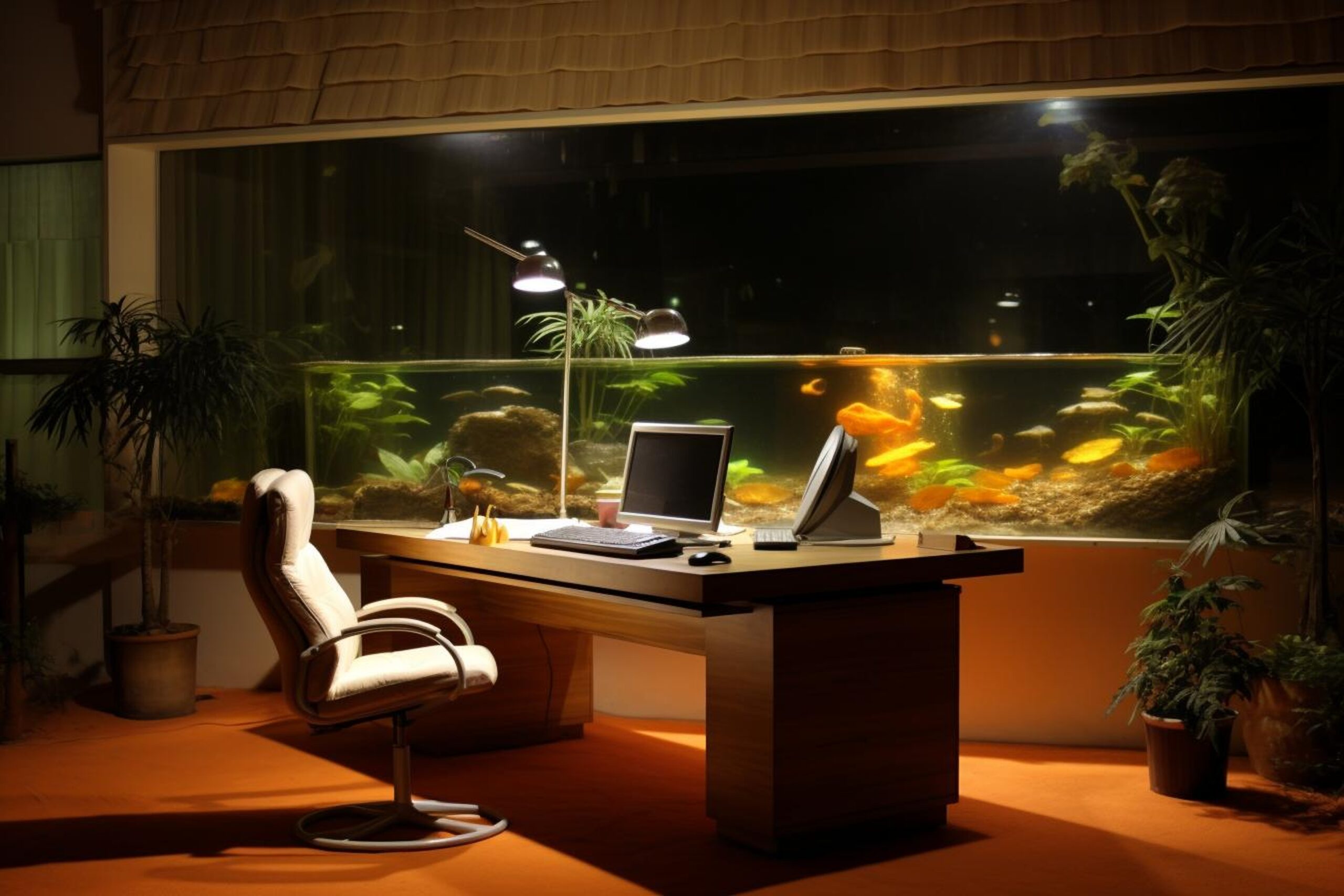In today’s world, where remote work has become increasingly common, creating a comfortable and functional home office is essential.
One of the most critical aspects of a well-designed home office is proper lighting.
Poor lighting can lead to eye strain, headaches, and decreased productivity.
On the other hand, the right home office lighting setup can help reduce eye strain, improve focus, and boost overall comfort.
In this article, we’ll explore the 5 best home office lighting setups that can help you create a workspace that is both visually appealing and easy on the eyes.
Whether you’re working from home full-time or just need a dedicated space for occasional remote work, these lighting ideas will help you create the perfect environment for productivity and comfort.
So, let’s dive in and discover how you can transform your home office with the power of light!
We strongly recommend that you check out our guide on how to take advantage of AI in today’s passive income economy.
Table of Contents
The Importance of Proper Home Office Lighting
Before we delve into the best home office lighting setups, it’s essential to understand why proper lighting is so crucial for your workspace.
When you work in a poorly lit environment, your eyes have to work harder to focus on the task at hand.
This extra strain can lead to a host of problems, including eye fatigue, headaches, and even blurred vision.
Over time, these issues can take a toll on your overall health and well-being, making it harder to stay focused and productive throughout the day.
Additionally, poor lighting can affect your mood and energy levels, making it more challenging to stay motivated and engaged in your work.
By investing in the right home office lighting setup, you can create a space that promotes both physical and mental well-being.
With the proper lighting, you’ll be able to work more comfortably and efficiently, without the added strain on your eyes and mind.
1. Natural Light: The Ultimate Eye-Friendly Solution
One of the best ways to reduce eye strain in your home office is to take advantage of natural light whenever possible.
Sunlight is the most balanced and eye-friendly light source available, providing a full spectrum of colors that can help reduce eye fatigue and improve overall well-being.
When setting up your home office, try to choose a room with ample windows that allow plenty of natural light to flow in.
Position your desk near a window, but be mindful of glare and direct sunlight, which can be counterproductive.
If necessary, use sheer curtains or adjustable blinds to diffuse the light and create a more comfortable working environment.
Remember to take breaks throughout the day to give your eyes a rest and enjoy the benefits of natural light outside your office space as well.
2. Task Lighting: Focusing on the Details
While natural light is ideal for overall illumination, task lighting is essential for focusing on specific work tasks without straining your eyes.
Task lighting refers to targeted light sources that illuminate your work area, such as your desk, keyboard, or paperwork.
When choosing a task light for your home office, look for adjustable options that allow you to direct the light where you need it most.
LED desk lamps with multiple brightness settings and color temperatures are an excellent choice, as they provide energy-efficient, customizable lighting that can adapt to your needs throughout the day.
Consider the size of your workspace and the type of tasks you typically perform when selecting the perfect task light for your home office.
3. Ambient Lighting: Setting the Mood for Productivity
In addition to task lighting, ambient lighting plays a crucial role in creating a comfortable and inviting home office atmosphere.
Ambient light provides overall illumination for the room, reducing the contrast between your work area and the surrounding space.
This helps to minimize eye strain and create a more balanced visual environment.
To achieve the perfect ambient lighting setup, consider using a combination of overhead fixtures, floor lamps, and wall sconces.
Dimmable options are particularly useful, as they allow you to adjust the light levels throughout the day based on your preferences and the amount of natural light available.
Soft, diffused light is generally more comfortable for the eyes than harsh, direct light, so consider using lampshades or frosted glass fixtures to create a more soothing ambiance.
4. Color Temperature: Choosing the Right Light for Your Space
When selecting light bulbs for your home office lighting setup, it’s essential to consider the color temperature of the light they emit.
Color temperature is measured in Kelvin (K) and ranges from warm, yellowish tones to cool, bluish hues.
The ideal color temperature for your home office depends on the type of work you do, your personal preferences, and the overall aesthetic of your space.
Generally, cooler light (around 4000-6500K) is best for tasks that require high concentration and accuracy, such as reading or working with numbers.
Warmer light (around 2700-3500K) is more relaxing and can be ideal for creative tasks or winding down at the end of the day.
Many modern LED bulbs offer adjustable color temperatures, allowing you to customize your lighting to suit your needs throughout the day.
5. Indirect Lighting: Reducing Glare and Shadows
Indirect lighting is another key strategy for reducing eye strain in your home office.
Unlike direct lighting, which shines directly on your work surface, indirect lighting bounces off walls and ceilings to provide a more diffused, even illumination.
This helps to minimize glare and shadows, which can cause eye fatigue and make it harder to focus on your work.
To incorporate indirect lighting into your home office setup, consider using uplights or wall washers that direct light towards the ceiling or walls.
You can also use light-colored or reflective surfaces, such as white walls or mirrors, to help distribute the light more evenly throughout the space.
By combining indirect lighting with task and ambient lighting, you can create a well-rounded, eye-friendly lighting setup that promotes productivity and comfort.
Putting It All Together: Creating Your Ideal Home Office Lighting Setup
Now that we’ve explored the various components of a good home office lighting setup, let’s look at how you can combine these elements to create the perfect workspace for your needs.
Start by assessing your space and identifying the areas that need the most attention.
Consider the size of your room, the location of windows, and the type of work you’ll be doing.
Next, plan your lighting layers, starting with ambient lighting to provide overall illumination, followed by task lighting for focused work, and finally, accent lighting to highlight specific areas or add visual interest.
When selecting fixtures and bulbs, opt for energy-efficient LED options with adjustable brightness and color temperature settings.
This will give you the flexibility to customize your lighting throughout the day and adapt to changing needs and preferences.
Don’t forget to incorporate natural light whenever possible, and use indirect lighting techniques to minimize glare and shadows.
Finally, take the time to experiment with different lighting setups and make adjustments as needed.
Pay attention to how your eyes feel after working for extended periods, and make changes if you experience any discomfort or strain.
With a little trial and error, you’ll be able to create a home office lighting setup that promotes productivity, comfort, and well-being.
Conclusion
Creating the perfect home office lighting setup is essential for reducing eye strain, improving focus, and boosting overall comfort and well-being.
By incorporating a combination of natural light, task lighting, ambient lighting, and indirect lighting techniques, you can create a workspace that is both functional and inviting.
Remember to choose energy-efficient, adjustable lighting options and take the time to experiment with different setups to find what works best for you.
With the right home office lighting, you’ll be well on your way to a more productive, comfortable, and visually appealing workspace.
FAQ
What kind of lighting is best for home office?
The best lighting for a home office is a combination of natural light, task lighting, and ambient lighting.
Natural light is the most eye-friendly and should be utilized whenever possible.
Task lighting, such as adjustable desk lamps, provides focused illumination for specific work tasks.
Ambient lighting, like overhead fixtures or floor lamps, offers overall room illumination to create a comfortable atmosphere.
Indirect lighting techniques can also be used to minimize glare and shadows.
When selecting bulbs, opt for energy-efficient LEDs with adjustable brightness and color temperature settings to customize your lighting throughout the day.
What are the lighting requirements for a home office?
The lighting requirements for a home office depend on several factors, such as the size of the room, the type of work being done, and personal preferences.
Generally, a home office should have a mix of natural light, task lighting, and ambient lighting to create a well-rounded, comfortable environment.
The Illuminating Engineering Society (IES) recommends a minimum of 300 to 500 lux (30 to 50 foot-candles) for general office work and 500 to 1000 lux (50 to 100 foot-candles) for tasks requiring more detail, such as drafting or reading small print.
It’s essential to have adjustable lighting options to accommodate different tasks and times of day and to minimize glare and shadows to reduce eye strain.
How do I create good lighting for my home office?
To create good lighting for your home office, start by assessing your space and identifying areas that need the most attention.
Maximize natural light by positioning your desk near windows and using sheer curtains or adjustable blinds to diffuse direct sunlight.
Incorporate task lighting, such as an adjustable desk lamp, to provide focused illumination for specific work tasks.
Add ambient lighting, like overhead fixtures or floor lamps, to create overall room illumination and a comfortable atmosphere.
Use indirect lighting techniques, such as uplights or wall washers, to minimize glare and shadows.
Choose energy-efficient LED bulbs with adjustable brightness and color temperature settings to customize your lighting throughout the day.
Experiment with different lighting setups and make adjustments as needed to find the perfect combination for your needs and preferences.
Where should I put lights in my home office?
When placing lights in your home office, consider the following tips:
- Position your desk near windows to take advantage of natural light, but be mindful of glare and direct sunlight.
- Place task lighting, such as a desk lamp, on your work surface to provide focused illumination for specific tasks.
- Install ambient lighting, like overhead fixtures or pendant lights, to provide overall room illumination.
- Use floor lamps or table lamps in corners or next to seating areas to create a comfortable, inviting atmosphere.
- Place uplights or wall washers to direct light towards the ceiling or walls for indirect illumination, minimizing glare and shadows.
- Consider the size of your room and the type of work you’ll be doing when deciding on the number and placement of lights.
Remember to create a layered lighting approach, combining natural light, task lighting, and ambient lighting for a well-rounded, comfortable home office lighting setup.

We strongly recommend that you check out our guide on how to take advantage of AI in today’s passive income economy.




